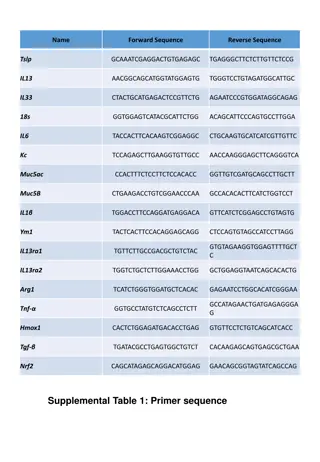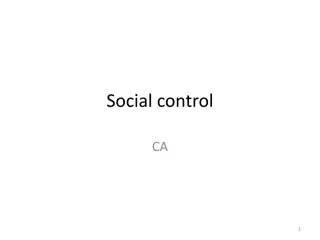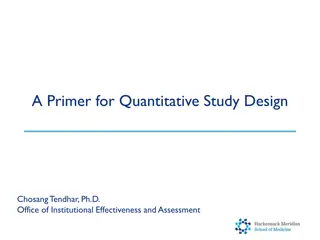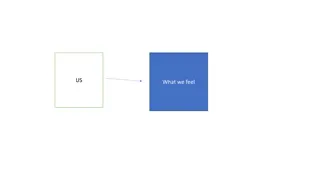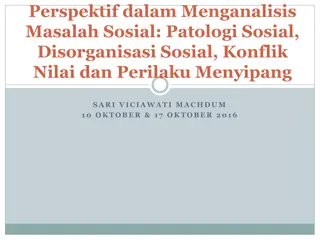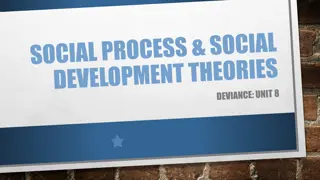Understanding Affect Control Theory in Social Science: A Primer
Affect Control Theory explores how individuals maintain an orderly society through repeated actions. This primer delves into the theory's elements, the intellectual terrain of the 1960s, addressing questions on societal order, and the control principle. It also highlights the theory's scope conditions for directed social behavior.
Download Presentation

Please find below an Image/Link to download the presentation.
The content on the website is provided AS IS for your information and personal use only. It may not be sold, licensed, or shared on other websites without obtaining consent from the author. Download presentation by click this link. If you encounter any issues during the download, it is possible that the publisher has removed the file from their server.
E N D
Presentation Transcript
Affect Control Theory: A Primer Lynn Smith-Lovin Duke University June 22, 2017 Dartmouth University
1960s 1960s The Intellectual Terrain The Intellectual Terrain Parson s Structural-Functionalism Structures evolve to fulfil necessary societal functions Actors internalize norms and gain from fulfilling expectations The over-socialized view of man (Wrong, 1961) The attitude-behavior controversy in psychology
The Question The Question How does an orderly society exist But, through repeated, spontaneous individual actions? AND How do people readily respond to new circumstances Unclear situations Repair misunderstandings And so on?
The Elements of the Theory The Elements of the Theory Define the Situation Cultural Sentiments EPA Impression Change The Control Principle
The Elements of the Theory The Elements of the Theory Define the Situation (Mead) Cultural Sentiments EPA (Osgood) Impression Change (Gollob) The Control Principle (Powers) Then Dave Heise Put It All Together
The Answer Came Earlier Than I Thought The Answer Came Earlier Than I Thought The control part came FIRST Norms, reality and angst when they don t match But, reality on what dimension? Then The Measurement of Meaning Browsing in the stacks Dave s dissertation and early monograph (1966) Then Dave followed up on Gollob the year after Gollob s first impression formation paper (1968-1969)
Scope Conditions (Robinson 2008) Scope Conditions (Robinson 2008) Directed social behavior Including self-directed ABO Actor, Behavior, Object At least one observer who is a member of an identified language culture The theory applies only to labeled aspects of social experience
Advances in Definition of the Situation Advances in Definition of the Situation Institutions are central Originally taken for granted BUT Doctors shouldn t nuzzle people! Goffman: A definition of situation is usually to be FOUND, not invented Originally fairly ad hoc, but now a new theory of institutions Cultural theory of people Lots of new work now on how important institutional frames are Perceived Likelihood Variance of Meanings or Impressions Formed
A Picture from the Past A Picture from the Past
A Picture from MacKinnon and A Picture from MacKinnon and Heise Heise (2010) (2010)
Some Questions in Passing Some Questions in Passing Do situations need to be consciously labeled? What about Bayesian uncertainty? Can master identities (gender, race) be under the radar? Are identities and behaviors at different levels of abstraction different in some way? More neutral in meaning? More variant in meaning?
Cultural Sentiments: EPA Cultural Sentiments: EPA Core importance: Mapping all elements of a social reality into one set of dimensions Allows for the mathematical statement of the theory Long history Osgood (and Dave s scanning of that earlier work) Dave s dissertation, Sewell and Heise 2010, the 1978 compendium
The EPA Dimensions The EPA Dimensions Evaluation Good, nice vs bad, awful Linked to status, esteem Potency Powerful, big vs. weak. Small Linked to power Activity Fast, young, noisy vs slow, old, quiet Linked to Expressiveness, Arousal
Evaluation Potency Activity deadbeat dad -3.30 -2.16 -2.39 hero 3.04 2.85 2.34 priest 2.07 1.69 -1.14 youngster 1.46 -1.19 2.15 prostitute -2.72 -2.21 1.59
The More Recent Work US 1978 to 2013-- UNC, Indiana, UGA, Mturk Northern Ireland, Canada, Japan, China, S Korea, Germany A flurry of investigations about whether structural position influences sentiments: Wisecup dissertation Rogers dissertation Ambrasat, Jens, Christian von Scheve, Markus Conrad, Gesche Schauenburg, and Tobias Schr der 2014, 2016 Kait Boyle s work
Heises Heise s Measurement Model for EPA Measurement Model for EPA
Some Tensions in Our Thinking about EPA Some Tensions in Our Thinking about EPA It is this model that allows us to combine individuals ratings into mean EPA values for measures of cultural sentiments But we also treat them as internalized, individual meanings (SI) Recent ACT summaries: Importing cultural meanings into local interactions Reasons for the shift: Challenges by people of color (the Slave) The situational nature of ACT (the Traffic Violater)
Challenges of the Measurement Model Challenges of the Measurement Model Problems with Measurement for Research If we really want measures of individuals sentiments Single item measures (high error) Or shift to multiple item measures of each dimension Especially important for new self-sentiment research A Long-forgotten Aspect of Our Scales Where did the +4.3, -4.3 come from? Successive Interval Scaling
The Scales and the Sliders The Scales and the Sliders Mother -4.3 4.3 Bad Good Nice Awful -4.3 4.3 Powerless Powerful Big Little Slow Fast Active Noisy -4.3 4.3 Inactive Quiet
What the Values Really Look Like What the Values Really Look Like
Impression Change Equations Sentiments Dictionaries of concept ratings (out of context) 3- number profiles Evaluation, potency, activity Impressions Event ratings (in context) Actor-Behavior-Object events Basic grammar of interaction Regress impressions on sentiments
EPA Ratings In the Context of an Event Mother Plays with Child Evaluation -4.3 4.3 Bad Good Nice Awful Potency -4.3 4.3 Powerless Powerful Big Little Activity Slow Fast Active Noisy -4.3 4.3 Inactive Quiet
Impression Change Equations Actor-Behavior-Object sentences A Mother B Plays with O Child A = a + b + o regressions help us see how actors impressions are shaped by their actions and the objects of those actions
Impression Change Equations Mother Plays with Child A e = -0.98 + .468Ae- .015Ap - .015Aa + .425Be + -.069Bp - .106Ba +.055Oe - .020Op - .001Oa + .048AeBe + .130 BeOe + .027ApBp + .068BpOp + .007AaBa - .038AeBp - .010AeBa + .013ApBe - .014ApOa - .058BeOp - .070BpOe - .002BpOa + .010BaOe +.014BaOp + .018ApBpOp Stability term Actors seem good when they occupy positive identities
Impression Change Equations Mother Plays with Child A e = -0.98 + .468Ae - .015Ap - .015Aa+ .425Be-.069Bp - .106Ba +.055Oe - .020Op - .001Oa + .048AeBe + .130 BeOe + .027ApBp + .068BpOp + .007AaBa - .038AeBp - .010AeBa + .013ApBe - .014ApOa - .058BeOp - .070BpOe - .002BpOa + .010BaOe +.014BaOp + .018ApBpOp Morality term Actors seem good when they behave in positive ways
Impression Change Equations Mother Plays with Child A e = -0.98 + .468Ae - .015Ap - .015Aa+ .425Be -.069Bp - .106Ba +.055Oe - .020Op - .001Oa+ .048AeBe + .130 BeOe + .027ApBp + .068BpOp + .007AaBa - .038AeBp - .010AeBa + .013ApBe - .014ApOa - .058BeOp - .070BpOe - .002BpOa + .010BaOe +.014BaOp + .018ApBpOp Network term Actors seem good when they hang out with positive others (Your mother was right!)
Impression Change Equations Mother Plays with Child A e = -0.98 + .468Ae - .015Ap - .015Aa +.425Be -.069Bp - .106Ba +.055Oe - .020Op - .001Oa+ .048AeBe + .130 BeOe + .027ApBp + .068BpOp + .007AaBa - .038AeBp - .010AeBa + .013ApBe - .014ApOa - .058BeOp - .070BpOe - .002BpOa + .010BaOe +.014BaOp + .018ApBpOp Consistency terms BeOe Balance: People seem nicer when they do good things to nice others (or harsh things to bad others)
Impression Change Equations Mother Plays with Child A e = -0.98 + .468Ae - .015Ap - .015Aa +.425Be -.069Bp - .106Ba +.055Oe - .020Op - .001Oa + .048AeBe + .130 BeOe + .027ApBp + .068BpOp + .007AaBa - .038AeBp - .010AeBa + .013ApBe - .014ApOa - .058BeOp - .070BpOe - .002BpOa + .010BaOe +.014BaOp + .018ApBpOp Congruency terms BeOp and BpOe: People seem nicer when they do good things to weak others (or diss powerful others); doing weak (gentle?) things to good people is nice
Since 1978, a Major Cottage Industry Since 1978, a Major Cottage Industry U.S., Canada, Japan, China, Germany, Egypt, Morocco One repeat measure: UNC78 and Duke10 New methodological advances (Heise 2015; Morgan et al 2016) BUT: The details are interesting for impression change, but not so important for predicting behavior or emotion EPA sentiments are most important Go for substance rather than just prediction?
Affect Control Principle Affect Control Principle Control System Reference State Cultural Sentiments Observed State Situated Meanings Response Behavior or Reinterpretation (labeling) Negative Feedback Loop Affect Control Principle: Individuals behave in ways that maintain their affective expectations generated by their definitions of the situation
Affect Control Principle Affect Control Principle Simulation Program INTERACT Uses Parameter Estimates to Model Social Behavior, Labeling, Emotion Deflection: The affective distance between sentiments and impressions created by events Deflection = (A e-Ae)2 +(A p-Ap)2 +(A a-Aa)2 + (B e-Be)2 +(B p-Bp)2 +(B a-Ba)2 + (O e-Oe)2 +(O p-Op)2 +(O a-Oa)2 Deflectionis a property of the interaction, not of individuals. (Nelson broke it down into the three subcomponents. Deflection minimized to solve for 3-number profiles of optimal behaviors (predicting action), identities/traits (predicting labeling). Simulation software program INTERACT implements control system to generate predictions using natural language input
In 1978 In 1978 The ENTIRE Theory Fit in 8K The ENTIRE Theory Fit in 8K
Empirical Validation Empirical Validation Laboratory Studies Wiggins & Heise 1987 Journal of Mathematical Sociology. Robinson & Smith-Lovin 1992 Social Psychology Quarterly. Youngreen, Conlon, Robinson & Lovaglia. 2009. Social Science Research. Schr der & Scholl. 2009. Social Psychology Quarterly. Field Studies Francis 1997. Social Psychology Quarterly. King. 2001. Social Science Computer Review King, Adam 2008. Social Science Computer. Hunt 2008. Social Psychology Quarterly. Francis 1997. Social Perspectives on Emotion. Smith-Lovin & Douglass. 1992. Social Perspectives on Emotions. Surveys MacKinnon & Langford 1994. Sociological Quarterly. Lively & Heise. 2004. American Journal of Sociology. Lively & Powell. 2006. Social Psychology Quarterly. Robinson & Smith-Lovin. 1999. Motivation and Emotion. Robinson, Smith-Lovin, Tsoudis 1994 Social Forces Cross-national Studies Smith, Matsuno, & Umino. 1994. Social Psychology Quarterly. Smith, Matsuno, & Ike. 2001. Social Psychology Quarterly. Smith 2002. Journal of Mathematical Sociology. Smith & Francis 2005. Social Forces. MacKinnon & Keating. 1989. Social Psychology Quarterly. Langford &, MacKinnon 2000. Social Psychology Quarterly. Smith, Umino, & Matsuno. 1998. Journal of Mathematical Sociology.
So Whats Not to Like? So What s Not to Like? Exactly what IS deflection? What it s not: negative emotion What it s probably not: stress A sense of unreality How do we ask about it? Can we get beyond just EVALUATION? How to better run experiments Determining definition of situation (labeling versus deflection of real self) Constraining alternatives for resolving deflection Will vignettes do it for us?
The Elements of the Theory The Elements of the Theory Define the Situation Cultural Sentiments EPA Impression Change The Control Principle
Amalgamation: Modification, Attribution and Amalgamation: Modification, Attribution and Emotion Emotion Impression Change, with Two Elements C = a + bM +bI Ce = -.32 + .69Me - .36Mp + .47Ie + .OlIp -.07Ia + .12MeIe Cp = -.18 - .l8Me + .65Mp + .59Ip + .05Ia Ca = -.11 - .04Me + .07Mp + .53Ma - .02Ie - .02Ip + .641a
Even Simpler Even Simpler But you can move the modifier out . Me = -.32 + .47Ie + .OlIp -.07Ia- Ce/(Ce+.12Ie+.69) Mp = -.18 - .OlIe + .59Ip + .05Ia - Cp/.65 Ma = -.11 - .02Ie - .02Ip + .64Ia - Ca/.53 And substitute the entire in-context equation for the C s!!
Which leads to M = t + (t-f) Most interesting for emotions (although we should probably do more with attribution) But it s only for evaluation: we should work out the others Emotions are a function of the transient impression and deflection (directed movement away from the fundamental) Characteristic emotions: associated with an maintained identity Structural emotions: associated with an maintained identity and a role-alter whose identity is also maintained Situated emotions: emotional responses after a disconfirming event
So lets get this right So let s get this right Who you are (identity) determines what you feel An actor is always feeling some emotion (although sometimes No Emotion ) Disconfirming identities does not necessarily lead to negative emotion Emotion and deflection are not the same thing, although they are related (distantly)
Some Persistent Some Persistent Q Questions about Emotions uestions about Emotions Again, why are we so fixated on evaluation? How can we measure without influencing the outcome? What IS the experienced impact of deflection, and how is it related to emotion? What is going on when INTERACT (so frequently) says that there are no emotions in range? What are the implications of the new Bayesian model for our understanding of situated emotions?








